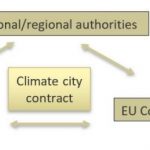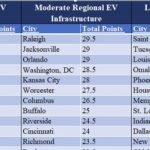The Biden administration has reintroduced Trump’s tariffs on e-bikes from China. That’s 25% tariffs on imported e-bikes and bike components made in China. An additional 25% tariff on Chinese-made battery packs used by e-bikes comes into effect in 2026. Nearly 100% of bicycles sold in the U.S. are manufactured abroad, with the vast majority coming from China. It’s all part of the U.S. policy to counteract unfair subsidies in China and develop … [Read more...]
Buildings Renovation: city-wide comprehensive data management tools to transform each building
In the U.S. the National Renewable Energy Laboratory (NREL) and Lawrence Berkeley National Laboratory have created a free-to-use (and develop) online data management tool – called SEED - that allows whole cities to collect details on thousands of buildings and use them to assess energy wastage at the single building level. Molly Rettig at NREL explains that hundreds of data points can be collected for each building. The tools, along with … [Read more...]
Implementing Poland’s national Recovery and Resilience Plan
How should Poland implement its national Recovery and Resilience Plan (RRP)? Sonia Buchholtz at Forum Energii outlines some important answers. First, a deep analysis of the challenges and assessment of the solutions and reforms must start now. Buchholtz says though the directions set out in the RRP are correct, the details are out-of-date. Policy reforms and more ambitious targets are needed in all the main areas: energy efficiency and heating; … [Read more...]
New research ranks the 12 best ways to cut car use in cities
Behaviour change is as an important part of our transition journey as the clean energy revolution. Kimberly Nicholas at Lund University summarises research that has gathered together nearly 800 peer-reviewed reports and case studies from across Europe that analyse ways of reducing car use. One main challenge is to quantify the benefits so policy-makers and citizens can make evidence-based decisions on how to re-imagine city mobility. Nicholas … [Read more...]
Intelligent, flexible Sector Coupling in cities can double the potential for Wind and Solar
This week the European Commission tabled the Energy Performance of Buildings Directive (EPBD) which should accelerate the decarbonisation of buildings. Buildings and cities play a key role in the energy transition. And the target high shares of variable renewable power supply will be much more easily achieved if the sectors using them display demand flexibility. In essence, that means using or storing the excess wind and solar generation … [Read more...]
Corporations, Cities, Financial Institutions: can private collective action plug the global emissions gap?
Non-state actors - corporations, cities, and financial institutions – are making their own impact on emissions reductions. We don’t just have to rely on governments, explain James Newcomb, Jun Ukita Shepard and Laurens Speelman at RMI. Case studies of harnessing private collective action already exist, and they are significant. Take Power Purchase Agreements (PPAs). In the U.S., corporates ramped up annual renewables procurements from 0.1 GW to … [Read more...]
Climate Neutral Cities can be the key to winning public support for the European Green Deal
The EC is currently considering a mission proposal to achieve “100 climate neutral cities by 2030 – by and for the citizens”. Arguing for its endorsement and the proposed umbrella governance, Simon Skillings and Eleonora Moro at E3G explain why cities are an ideal laboratory for tackling the big unanswered question: which European Green Deal (EGD) pathways will win genuine public support. No one should doubt that the EGD will be disruptive. So … [Read more...]
Rolling out EV charging infrastructure beyond cities
“Range anxiety” causes people not to buy EVs because they’re afraid they won’t be able to travel very far if charging facilities don’t extend beyond metropolitan centres. Jimmy Gilman at RMI describes their study of what infrastructure exists on the outskirts of U.S. cities, and at tourist destinations and airports outside the cities. 60 cities, encompassing more than 57% of the U.S. population, have been given scores. The coastal areas perform … [Read more...]
City-level emissions reductions: what can successful cities teach us
The EU Covenant of Mayors for Climate and Energy (EUCoM) requires their member cities to commit to exceeding their national goals. EUCoM is one of the world’s largest subnational climate action networks, with over 1,000 cities and home to 50m people. Writing for Carbon Brief, Angel Hsu, Nihit Goyal and Amy Weinfurter at Yale-NUS College review the data to see how successful they have been. About 40% of the cities show emission reductions that are … [Read more...]










